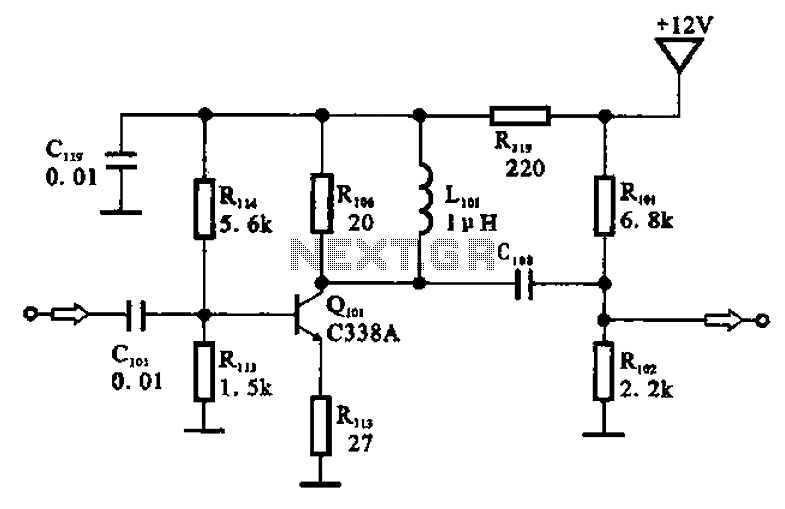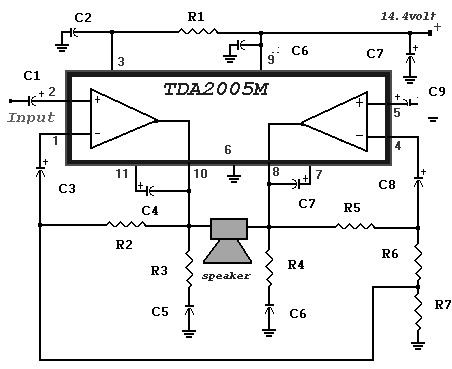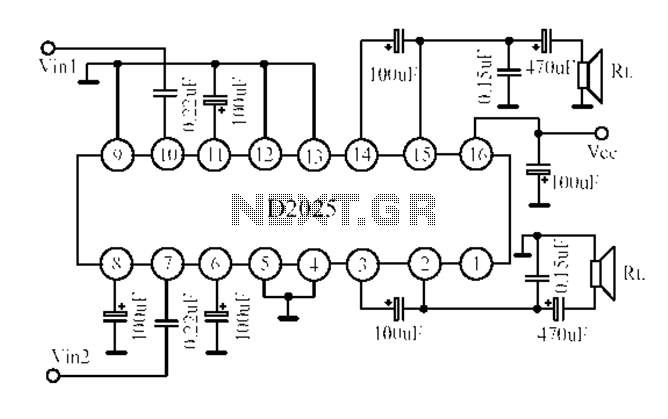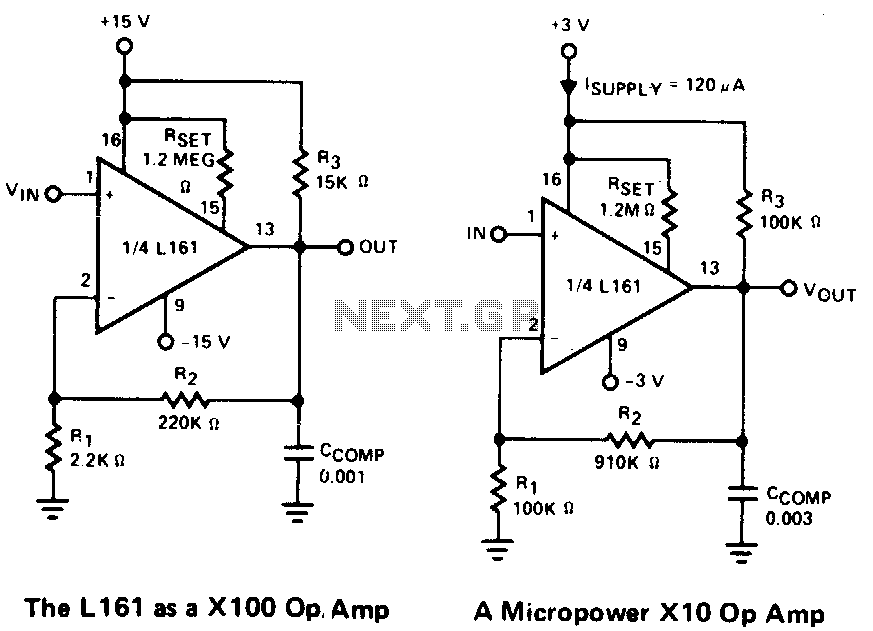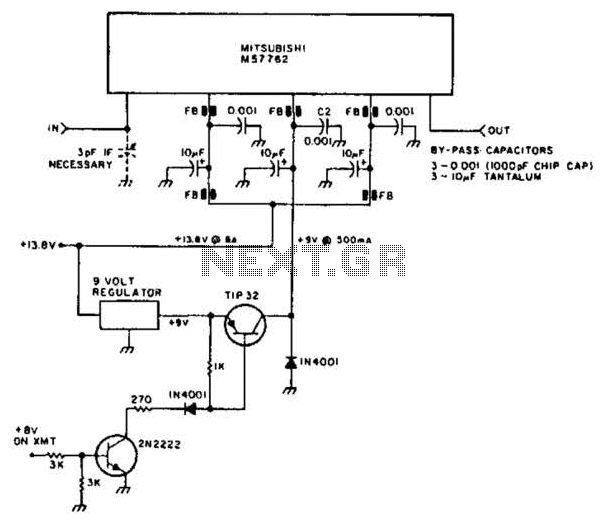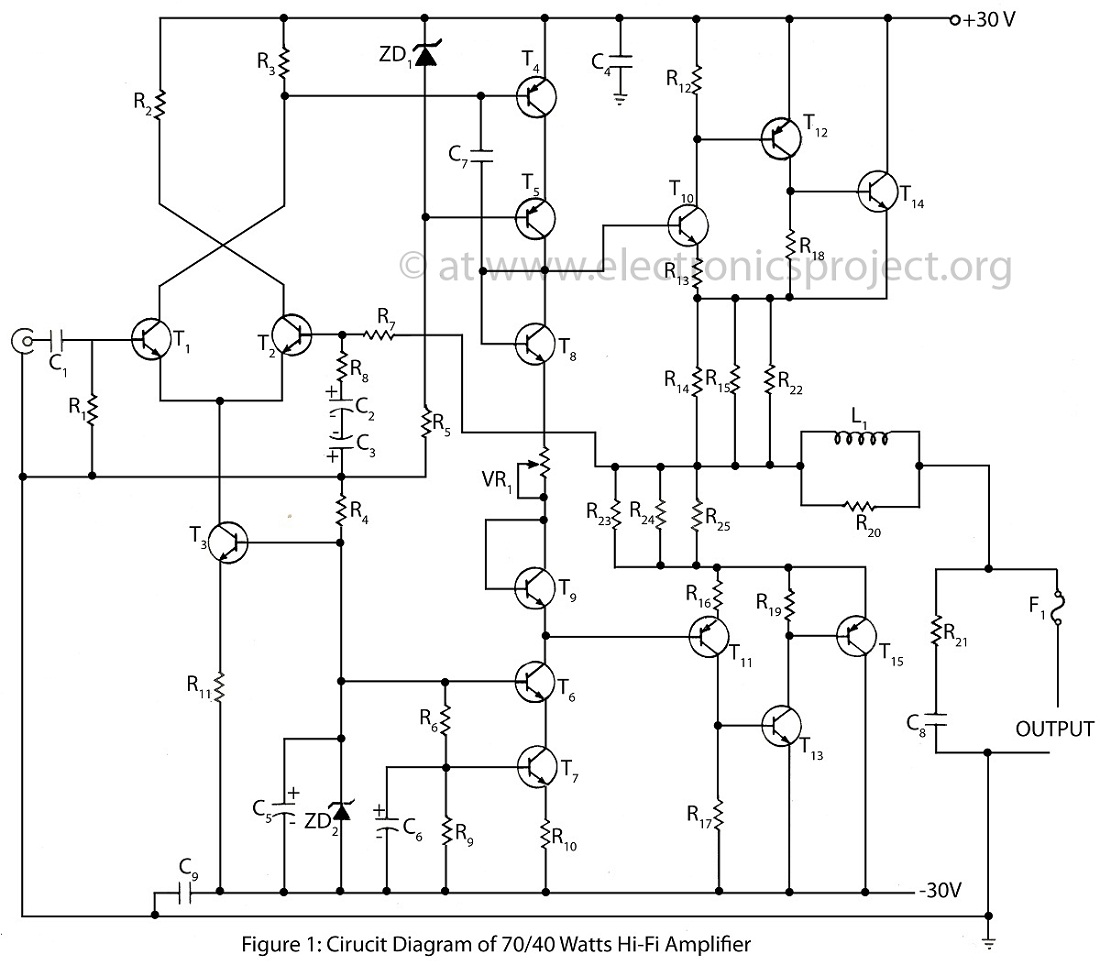
1W guitar amplifier
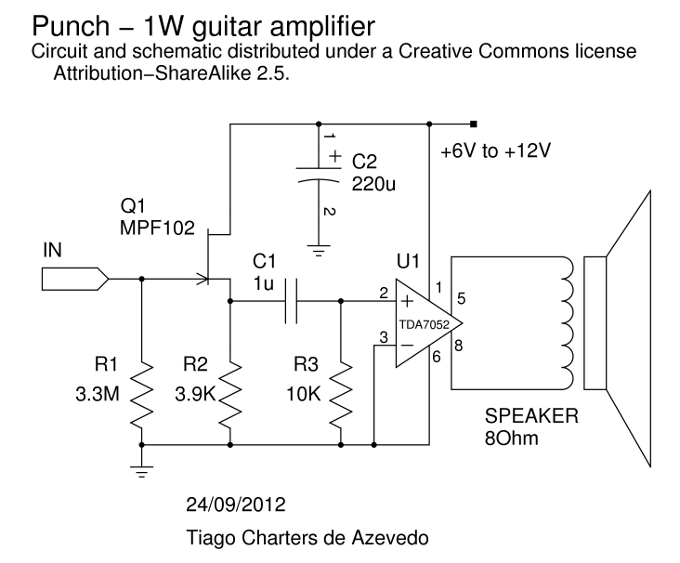
An alternative to the well-known ROG Ruby amplifier, this design shares a similar topology, featuring a buffer and a chip amplifier. It employs a JFET buffer utilizing the MPF102, along with the 1W TDA7052 chip. The amplifier delivers a clean sound and responds excellently to any pedals used in conjunction with it. It is designed without volume and tone controls for a straightforward plug-and-play experience. For those seeking an amplifier with volume control, the TDA7052A variant is recommended, as it includes a voltage control pin for a simple potentiometer, ensuring that the volume control does not interfere with the signal path. The PUNCH amplifier can operate on a 9V battery or six 1.5V batteries in series. At lower voltages and currents, sound quality may degrade, leading to distortion; in such cases, reducing the 1µF capacitor to 470nF or smaller may help.
Regarding speaker recommendations for mini-amp circuits, while the Ruby, Little Gem, and Little Gem MkII can function with various speakers, optimal performance is achieved with full-size speakers designed for guitar amplification. These amplifiers are compatible with total impedances of 4, 8, or 16 ohms. Tests with hi-fi speakers, clock-radio speakers, and automotive speakers have shown that they do not perform well; however, it has been noted that 6-inch automotive speakers yield satisfactory results, particularly with the PUNCH model. An example of a suitable speaker is the Fonestar UT528, which measures 5.25 inches (13.3 cm) with a frequency response of 50-12,000 Hz and a sensitivity of 90 dB at 1 W/1 m.
The described amplifier circuit utilizes a JFET buffer stage, which provides high input impedance and low output impedance, making it ideal for interfacing with various signal sources without loading them down. The MPF102 JFET is a common choice for this application due to its favorable characteristics, such as low noise and high gain. The TDA7052 chip amplifier is a compact integrated solution that delivers up to 1W of output power, suitable for driving small speakers in practice amp applications.
The absence of volume and tone controls simplifies the design, making it user-friendly and suitable for quick setups. For users who prefer a volume control, the TDA7052A variant offers an elegant solution without compromising audio quality, as the volume adjustment does not interfere with the audio signal path.
Powering the amplifier with a 9V battery or a series of smaller batteries allows for portability, making it convenient for practice sessions or on-the-go use. However, it is crucial to consider the power supply's voltage and current capabilities, as lower voltages may lead to sound distortion. The suggested capacitor adjustments can help mitigate these issues by altering the frequency response characteristics of the amplifier.
When selecting speakers, it is essential to choose those designed for electric guitar frequencies to achieve the best sound quality. The impedance compatibility and frequency response of the speaker must align with the amplifier's output characteristics to ensure optimal performance. The Fonestar UT528 speaker is an excellent example, providing a suitable frequency range and sensitivity for use with this amplifier circuit, ensuring a rich and full sound during operation.An alternative to the infamous ROG `s Ruby amp. As you see it shares with the Ruby the same topology: a buffer and a chip amp. It uses a JFET buffer with a MPF102 and the 1W TDA7052 chip. It is a clean amp and it reacts very well with any pedal in front of it. I don`t use a lot of distortion so this little amp suits all my needs. It doesn`t have a volume and tone control because I wanted a plug-in-and-play amp. If you want an amp with a volume control try the TDA7052A, it has a volume voltage control pin that works perfectly (simple pot), this chip has the advantage that the volume pot is not on the signal path. Of course the PUNCH also works with batteries, a 9v battery or with six 1. 5V batteries in series. For small voltages and currents the sound could become distorted or to muddy, if so decrease the 1u cap to 470n or smaller.
What speakers do you recommend for use with your mini-amp circuits While the Ruby, Little Gem, and Little Gem MkII practice amps can be used with any speakers, best results are achieved with full-size speakers intended for use with guitar amps. The amps will work well with an total impedance of 4, 8, or 16 ohms. We`ve tried hi-fi speakers, clock-radio speakers, and auto speakers - they just can`t cut it. For me, using anything other than a speaker designed for the frequencies of an electric guitar produced sounds more like a toy than an actual amp.
However, you may want to ask at Aron`s Stompbox Forum. Many of the members have built one of the aforementioned amps and may be able to suggest a decent-sounding small speaker. This is only in part true. One thing they are right is that clock-radio speakers and small radio speakers won`t work! But the same is not true for hi-fi speakers and auto speakers. Let me be more precise about it. I`ve tested the PUNCH and the Ruby with some 6`` auto speakers and they work great, specially with the PUNCH.
This Fonestar UT528 speaker of 5. 25``=13. 3cm with a frequency response of 50-12. 000 Hz and a sensitivity of 90 dB - 1 W/1 m works great. 🔗 External reference
Regarding speaker recommendations for mini-amp circuits, while the Ruby, Little Gem, and Little Gem MkII can function with various speakers, optimal performance is achieved with full-size speakers designed for guitar amplification. These amplifiers are compatible with total impedances of 4, 8, or 16 ohms. Tests with hi-fi speakers, clock-radio speakers, and automotive speakers have shown that they do not perform well; however, it has been noted that 6-inch automotive speakers yield satisfactory results, particularly with the PUNCH model. An example of a suitable speaker is the Fonestar UT528, which measures 5.25 inches (13.3 cm) with a frequency response of 50-12,000 Hz and a sensitivity of 90 dB at 1 W/1 m.
The described amplifier circuit utilizes a JFET buffer stage, which provides high input impedance and low output impedance, making it ideal for interfacing with various signal sources without loading them down. The MPF102 JFET is a common choice for this application due to its favorable characteristics, such as low noise and high gain. The TDA7052 chip amplifier is a compact integrated solution that delivers up to 1W of output power, suitable for driving small speakers in practice amp applications.
The absence of volume and tone controls simplifies the design, making it user-friendly and suitable for quick setups. For users who prefer a volume control, the TDA7052A variant offers an elegant solution without compromising audio quality, as the volume adjustment does not interfere with the audio signal path.
Powering the amplifier with a 9V battery or a series of smaller batteries allows for portability, making it convenient for practice sessions or on-the-go use. However, it is crucial to consider the power supply's voltage and current capabilities, as lower voltages may lead to sound distortion. The suggested capacitor adjustments can help mitigate these issues by altering the frequency response characteristics of the amplifier.
When selecting speakers, it is essential to choose those designed for electric guitar frequencies to achieve the best sound quality. The impedance compatibility and frequency response of the speaker must align with the amplifier's output characteristics to ensure optimal performance. The Fonestar UT528 speaker is an excellent example, providing a suitable frequency range and sensitivity for use with this amplifier circuit, ensuring a rich and full sound during operation.An alternative to the infamous ROG `s Ruby amp. As you see it shares with the Ruby the same topology: a buffer and a chip amp. It uses a JFET buffer with a MPF102 and the 1W TDA7052 chip. It is a clean amp and it reacts very well with any pedal in front of it. I don`t use a lot of distortion so this little amp suits all my needs. It doesn`t have a volume and tone control because I wanted a plug-in-and-play amp. If you want an amp with a volume control try the TDA7052A, it has a volume voltage control pin that works perfectly (simple pot), this chip has the advantage that the volume pot is not on the signal path. Of course the PUNCH also works with batteries, a 9v battery or with six 1. 5V batteries in series. For small voltages and currents the sound could become distorted or to muddy, if so decrease the 1u cap to 470n or smaller.
What speakers do you recommend for use with your mini-amp circuits While the Ruby, Little Gem, and Little Gem MkII practice amps can be used with any speakers, best results are achieved with full-size speakers intended for use with guitar amps. The amps will work well with an total impedance of 4, 8, or 16 ohms. We`ve tried hi-fi speakers, clock-radio speakers, and auto speakers - they just can`t cut it. For me, using anything other than a speaker designed for the frequencies of an electric guitar produced sounds more like a toy than an actual amp.
However, you may want to ask at Aron`s Stompbox Forum. Many of the members have built one of the aforementioned amps and may be able to suggest a decent-sounding small speaker. This is only in part true. One thing they are right is that clock-radio speakers and small radio speakers won`t work! But the same is not true for hi-fi speakers and auto speakers. Let me be more precise about it. I`ve tested the PUNCH and the Ruby with some 6`` auto speakers and they work great, specially with the PUNCH.
This Fonestar UT528 speaker of 5. 25``=13. 3cm with a frequency response of 50-12. 000 Hz and a sensitivity of 90 dB - 1 W/1 m works great. 🔗 External reference
